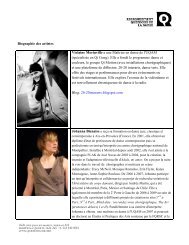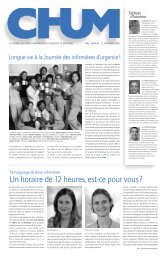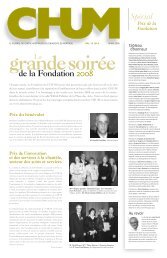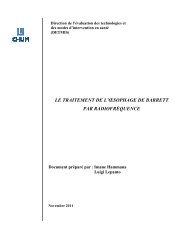la chirurgie assistée par robot da vinci en gynécologie oncologique
la chirurgie assistée par robot da vinci en gynécologie oncologique
la chirurgie assistée par robot da vinci en gynécologie oncologique
You also want an ePaper? Increase the reach of your titles
YUMPU automatically turns print PDFs into web optimized ePapers that Google loves.
Executive summary<br />
Introduction :<br />
In rec<strong>en</strong>t decades, the medical world has se<strong>en</strong> the emerg<strong>en</strong>ce of a multitude of<br />
medical and surgical interv<strong>en</strong>tions described as minimally invasive. The objective<br />
of these techniques is to reduce complications and trauma associated with<br />
conv<strong>en</strong>tional surgery and to improve treatm<strong>en</strong>t outcome.<br />
Methods :<br />
Results :<br />
The Da Vinci <strong>robot</strong>ic system, product of the Intuitive Surgical Inc., was approved<br />
by the FDA in 2000 for abdominal and pelvic surgery, and in 2005 for<br />
hysterectomy. There are curr<strong>en</strong>tly over than 1330 Da Vinci <strong>robot</strong>ic systems in the<br />
world, including 980 in the U.S.A. and only 2 in Quebec.<br />
This report was requested by the chiefs of the De<strong>par</strong>tm<strong>en</strong>t of surgery and<br />
gynaecologic oncology in order to undertake an evaluation of the effectiv<strong>en</strong>ess<br />
and costs of the <strong>robot</strong>ic-assisted surgery.<br />
This report is a systematic literature review of the feasibility, clinical effectiv<strong>en</strong>ess<br />
and effici<strong>en</strong>cy of the <strong>robot</strong>ic-assisted surgery com<strong>par</strong>ed to <strong>la</strong><strong>par</strong>oscopy and<br />
<strong>la</strong><strong>par</strong>otomy in the oncologic gynecology field.<br />
The studies published to <strong>da</strong>te are case series. No randomized study is yet<br />
avai<strong>la</strong>ble. As for economic assessm<strong>en</strong>t studies, the only report avai<strong>la</strong>ble is the one<br />
published in 2009 by the Belgian C<strong>en</strong>tre fédéral d’expertise des soins de santé.<br />
In g<strong>en</strong>eral gynecology, published case series reported a mean operative time<br />
varying from 90 minutes to 192 minutes (a com<strong>par</strong>ative case series reported a<br />
longer operative time in <strong>robot</strong>ic group com<strong>par</strong>ed to <strong>la</strong><strong>par</strong>otomic group). Mean<br />
blood loss ranged betwe<strong>en</strong> 61 and 90 ml. The mean hospital stay was one <strong>da</strong>y.<br />
Regarding the use of <strong>robot</strong>-assisted surgery in the treatm<strong>en</strong>t of <strong>en</strong>dometrial cancer,<br />
com<strong>par</strong>ative case series show a fairly simi<strong>la</strong>r efficacy betwe<strong>en</strong> the three com<strong>par</strong>ed<br />
interv<strong>en</strong>tions (<strong>robot</strong>-assisted surgery, <strong>la</strong><strong>par</strong>oscopy and <strong>la</strong><strong>par</strong>otomy).<br />
Thus, the mean operative time varies from 177 to 242 min. for the <strong>robot</strong>ic groups,<br />
156 to 287 min. for the <strong>la</strong><strong>par</strong>oscopic groups and 79 to 146 min. for the <strong>la</strong><strong>par</strong>otomy<br />
groups. The mean blood loss was significantly lower in pati<strong>en</strong>ts operated with the<br />
<strong>robot</strong>: the mean blood loss varied from 50 to 166 ml in the <strong>robot</strong> groups, 145 to<br />
250 ml and 241to 316 ml in the <strong>la</strong><strong>par</strong>otomy and <strong>la</strong><strong>par</strong>oscopic groups respectively.<br />
The mean hospital stay is re<strong>la</strong>tively simi<strong>la</strong>r in <strong>la</strong><strong>par</strong>oscopic and <strong>robot</strong>ic groups (1-<br />
2 <strong>da</strong>ys) and 3 to 4 <strong>da</strong>ys in the <strong>la</strong><strong>par</strong>otomy group. However, there is some decrease<br />
in the rate of complications for pati<strong>en</strong>ts operated using the <strong>robot</strong> (3.6% to 13%)<br />
com<strong>par</strong>ed with <strong>la</strong><strong>par</strong>oscopic group (14% to 22%) and <strong>la</strong><strong>par</strong>otomy group (20.8% to<br />
29.7%). In addition, other indicators such as number of lymph nodes retrieved and<br />
the conversion rate show a certain superiority of <strong>robot</strong>ic operations.<br />
DETMIS -v-









